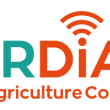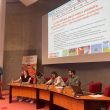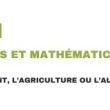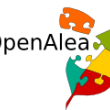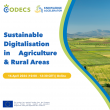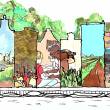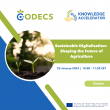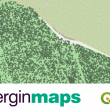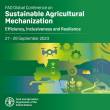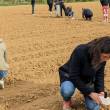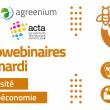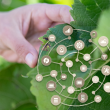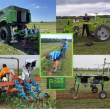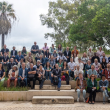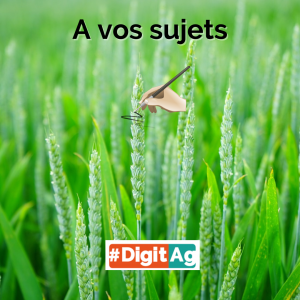-
[hal-05155592] Differences in growth features between species are driving cereal-legume intercrop yield: A statistical learning approach based on aggregated dataset
Increasing crop diversification is crucial for developing more sustainable agricultural systems, and cereal-legume intercropping is a promising strategy. This study investigates the factors influencing the yield of cereal-legume intercrops using data from six field experiments in southwestern France, where durum wheat was intercropped with either faba bean or pea. We assessed how differences in plant traits (e.g., height or biomass growth rates) between the associated species were related to the intercrop productivity. Additionally, we developed a novel modeling approach, combining machine learning and mixed-effects models, to identify the key drivers of intercrop performance based on variable importance. Our results showed that interspecific differences in plant traits within intercrops, particularly in biomass accumulation rate, maximum leaf area index, and elongation rates, were the most important factors explaining intercrop yield. These traits and their differences mainly suggest that competitive processes shape the outcome of a mixture and highlight the importance of dynamic measurements in agronomic experiments. The relationship between species yield and trait differences was symmetric for both intercropped species. Furthermore, these relationships were scale-dependent, with trends observed at the aggregate level not always consistent at the level of individual experiments. Our study highlights the importance of considering trade-offs when designing intercropping systems for practical applications and demonstrates the value of combining machine learning with ecological knowledge to gain insights into complex agricultural systems from aggregated datasets.
ano.nymous@ccsd.cnrs.fr.invalid (Rémi Mahmoud) 10 Jul 2025
https://hal.science/hal-05155592v1
-
[hal-05121068] What is the best way to communicate the uncertainty of a digital soil mapping product? Some lessons from an end-users survey
Uncertainty in digital soil mapping products is generally quantified and presented alongside the predictions in the form of a second raster map. However, it remains a challenge for end-users to integrate this additional information into their decision-making, and as a result, they tend to ignore uncertainty. The Digital Soil Mapping (DSM) literature has identified two levers for better communicating uncertainty: uncertainty representations that allow users to integrate uncertainty better than with a separate raster map, and spatial aggregation, which consists of representing the spatial information at a coarser resolution to reduce its uncertainty. For the first time in DSM, we involved a large number of end-users (263 people) via a webbased survey to evaluate alternative cartographic representations of soil map uncertainty. Respondents were assigned a decision-making task and asked to select the map that offered the best support, choosing between two maps that displayed the same soil information but differed in how uncertainty was represented and/or in the level of spatial aggregation. The choices made by the respondents as well as the comments they left at the end of the study provided a large dataset from which we could identify factors driving their preferences. We demonstrate that end-users strongly prefer uncertainty to be shown on a separate map, and also favor moderately aggregated maps. Our results question the conventional representation of soil data using highresolution and high-uncertainty maps. We hope that this work will be valuable to scientists in soil science, as well as in other environmental mapping communities, such as ecosystem services and biodiversity, and help them more effectively communicate uncertainty to their end-users.
ano.nymous@ccsd.cnrs.fr.invalid (Léa Courteille) 19 Jun 2025
https://hal.inrae.fr/hal-05121068v1
-
[hal-05094589] Digitainability – une convergence entre numérique et pratiques agricoles durables est-elle possible ?
[...]
ano.nymous@ccsd.cnrs.fr.invalid (Isabelle Piot-Lepetit) 03 Jun 2025
https://hal.inrae.fr/hal-05094589v1
-
[hal-05117250] The Survival of food platforms: The crucial role of alliance strategies in supply control for french platforms
This research focuses on the survival of a new actor in food systems: e-commerce platforms. They are confronted with the instability of supply by farmers. We mobilize the theory of resource dependence to understand what strategies they use to cope with this uncertainty. To this end, we conduct a survey of 103 platforms in France, a country where food e-commerce is well developed. Our results show that the platforms with the best survival rate are those that have reached a sufficient size and that manage their relationships with farmers in the form of an alliance, while controlling the quantity and quality of supply.
ano.nymous@ccsd.cnrs.fr.invalid (Romane Guillot) 17 Jun 2025
https://hal.science/hal-05117250v1
-
[hal-05041681] Exploring the optimality of threshold-based crop irrigation feedback strategies
The development of effective crop irrigation strategies is a key element of water management in agriculture, seeking a necessary parsimonious use of resources. Years of practice and accumulation of knowledge have led to numerous irrigation policies, including Threshold-Based Irrigation Strategies (TBIS). This work involves the Controlled Crop Irrigation (CCI) model, a simple dynamical system describing the order-1 biophysical processes at play, for which optimal irrigation policies may be proven and written as TBIS. We aim at studying both the optimal TBIS and their sub-optimal declensions, to identify the most influential parameters (which dictate the structure of optimal irrigation scenarios) but also the effects of errors made on their determination. Much attention is therefore drawn to the crucial "decision time" at which the irrigator decides to increase soil water content from an initial "stress tolerance level" to a "maximal biomass production" setpoint. In this study, we couple known results from optimal control theory and numerical methods for sensitivity analysis and global model exploration. The most striking results are that the optimal decision time is mostly driven by plant growth dynamics and the correct evaluation of stress effects on biomass production, as slightly too low soil moisture levels during the productive stage induce significant losses in final biomass. The genericity of the CCI model and the modularity of the methodology offer promising perspectives for various operational contexts.
ano.nymous@ccsd.cnrs.fr.invalid (Ruben Chenevat) 21 Apr 2025
https://hal.science/hal-05041681v1
-
[hal-05053996] How do farmers manage to take best advantage of semi-natural and wooded pastures in Mediterranean agro-silvo-pastoral systems ?
This study investigates pastoral practices in Mediterranean agro-silvopastoral systems through interviews with 18 small ruminant farmers in southern France. It highlights a wide diversity of grazing strategies shaped by production goals, livestock types, and land characteristics. Farmers who place strong value on grazing adapt their practices seasonally, rely on a broad range of resources (herbaceous and woody), and build their decisions on daily observations of animals and vegetation. The study emphasizes the importance of local ecological knowledge in adaptive rangeland management and its central role in the long-term sustainability of Mediterranean livestock systems.
ano.nymous@ccsd.cnrs.fr.invalid (Elisa Deschamps) 02 May 2025
https://hal.inrae.fr/hal-05053996v1
-
[hal-04959064] Early detection of Zymoseptoria tritici infection on wheat leaves using hyperspectral imaging data
This article presents a hyperspectral imaging (HSI) database of healthy leaves and leaves infected with Zymoseptoria tritici fungal pathogen responsible for leaf blotch (Lb) disease. Leaves of two durum wheat genotypes were studied under controlled conditions to track the evolution of Lb disease and capture significant spectral and spatial differences until the onset of symptoms. Hyperspectral image acquisitions were purchased with two cameras in visible-near infrared (VNIR) and short-wave infrared (SWIR) spectral ranges on eighteen dates between one day before inoculation and twenty days after inoculation. For each wavelength range studied, a total of 1175 images provided information on 3326 leaves measured throughout the experiment. These data are valuable since they can be used as a basis to monitor disease's development over time, to build leaf classification models according to their infection status per genotype per day, to develop prediction models related to symptoms' appearance, or to test imaging and spectral analysis methods.
ano.nymous@ccsd.cnrs.fr.invalid (Lorraine Latchoumane) 11 Mar 2025
https://hal.science/hal-04959064v1
-
[hal-04506042] Le développement du numérique en agriculture : vers une transformation agro-écologique ?
Le développement du numérique est mis en avant comme solution aux enjeux économiques et environnementaux de l’agriculture, alors que ses effets font l’objet de controverses. Cet article cherche à montrer comment le développement du numérique dans le secteur agricole impacte et s’intègre dans les différents modèles agricoles. Pour cela, il propose une approche en économie institutionnelle et multi-niveaux des systèmes d’innovation, mise en oeuvre à travers une méthodologie associant analyses quantitatives et qualitatives. À l’échelle des organisations du système d’innovation agricole, selon que les acteurs se rattachent à l’agriculture biologique ou conventionnelle, les attentes et risques perçus, ainsi que les stratégies de digitalisation, sont différents. Ces différences sont toutefois peu perçues par les acteurs du numérique. A l’échelle des exploitations agricoles, à partir de 98 entretiens avec des agriculteurs, des profils d’usage du numérique sont construits. Dans l’ensemble, les usages du numérique dans les exploitations accompagnent plutôt des stratégies d’écologisation faible, ou symbolique, associées à une trajectoire d’industrialisation, caractérisée par la spécialisation, la concentration, le recours croissant au salariat et à la sous-traitance et l’intégration dans les chaînes de valeur agrialimentaires. Ce travail met en évidence que les perceptions et usages du numérique diffèrent selon les modèles agricoles auxquels les acteurs se rattachent. La digitalisation n’apparaît pas comme la résultante de comportements dits « pionniers » mais dépend de la diversité des modèles et paradigmes, en interaction avec un système socioéconomique qui propose, incite, voire impose ces technologies. La digitalisation actuelle montre plusieurs formes d’oppositions vis-à-vis de la transition agroécologique, que ce soit en termes techniques, d’objectif, de raisonnement, de dynamique temporelle mais aussi d’enjeux politiques et sociaux. Des hybridations semblent toutefois possibles dans le cas de formes d’écologisation industrielle, mais aussi à travers une transformation plus globale de la digitalisation elle-même en repensant ses modèles techniques, économiques et politiques.
ano.nymous@ccsd.cnrs.fr.invalid (Éléonore Schnebelin) 15 Mar 2024
https://hal.inrae.fr/hal-04506042v1
-
[hal-05006930] How can digitalisation contribute to sustainability of business models in agri-food value chains? A systematic literature review
The expectations of digital technologies in sustainable agricultural development are considerable. However, applying these technologies in agri-food value chains can have downsides, which are still barely studied. The main objectives of this systematic literature review were to discover the state of the art of the research in the use of digital technologies in business models contributing to sustainability in the agri-food sector, and to make recommendations for future research and management practice. In order to bring concepts together and develop a theoretical framework and advance knowledge, performing a literature review is conducive. Here, the commonly-used PRISMA-method was used to develop a systematic literature review. From this review, an overview of business model innovations, and drivers, benefits and drawbacks of digitalisation in agri-food value chains were distinguished. Key themes found in the literature were the effects of COVID-19 on digitalisation and business resilience, the economic sustainability of business models, and the importance of communication technologies in agri-food value chains. This article recommends for future research and management practice to use a framework that looks through a value co-creation and open innovation perspective to the individual business model level and the interaction between (sustainable) business models in local and global food systems.
ano.nymous@ccsd.cnrs.fr.invalid (Laura Eline Slot) 26 Mar 2025
https://hal.inrae.fr/hal-05006930v1
-
[tel-05022755] Impact of cartographic representation of uncertainty for decision-making : the case of soil quality in land-use planning
Accurate and spatially explicit information is essential for more informed spatial planning decisions. However, this information comes with significant uncertainty which is often poorly communicated. While map producers have primarily focused on quantifying uncertainty, they have largely overlooked end-users' needs and preferences regarding its representation. As a result, users struggle to interpret and incorporate this information into their decision-making, frequently leading to its disregard. In this thesis, we took the example of a soil quality map produced using Digital Soil Mapping techniques, and followed its entire lifecycle, from the initial spatial predictive mapping to its use in land planning decisions. Along the way, we developed and implemented specific methodologies to improve the map from an end-user’s point of view. To improve the relevance of the map for local decision making, we tried to reduce the uncertainty by increasing the size of the soil dataset used to calibrate the DSM model. To improve map integrity, we performed an uncertainty analysis that included not only the mapping errors but also the errors conveyed by the soil quality indicator. To improve the intelligibility of map uncertainty representations, we tested both spatial aggregations of predicted maps using an agglomerative clustering algorithm and an alternative visualisation technique involving a coincident representation of uncertainty using glyphs. Ultimately, we conducted an experiment involving 283 end-users of soil maps using a web-based survey to identify their preferences regarding the representation of uncertain soil quality information, and assess the impact of map features on their decision-making. Our main findings were that 1) increasing the size of the calibration datasets significantly reduced the uncertainties of the DSM products involved in the production of the soil quality map, but resulted in only a moderate reduction in the uncertainty of the final soil quality map, 2) errors affecting the definition of the soil quality indicators made a small but non-negligible contribution to the overall uncertainty of the soil quality map, 3) agglomerative clustering outperformed other spatial aggregation techniques in reducing uncertainty while preserving the representation of fine soil variation, 4) end-users tend to prefer moderately aggregated map products over traditional raster DSM products and uncertainty representations by separate maps over coincident representations, 5) decision-making was significantly hindered when uncertainty values exceeded a given threshold, 6) there were clear differences in the factors influencing decision making depending on whether the decision was to authorise soil sealing or to protect against sealing. The findings of this thesis allowed us to formulate recommendations for soil map production that better accounts for uncertainty. We hope that these recommendations will assist map-makers in meeting end-users' needs, and that it will contribute to a more effective use of environmental maps in policy-making.
ano.nymous@ccsd.cnrs.fr.invalid (Léa Courteille) 12 Jun 2025
https://hal.inrae.fr/tel-05022755v2
-
[hal-05024427] Exploring the Potential of Agent-Based Models for the Problem of Transhumance Path Exits in Sub-Saharan Africa: Chad’s Routes as a Case Study
Path exits for transhumant livestock are a major problem in many Sub-Saharan African countries. These problems contribute to many community conflicts. Several solutions are currently being studied, including dialogues between stakeholders. In this paper, we propose a numerical approach to address the problem. Based on a commonly accepted model of agent movement, we propose a path simulator to estimate and quantify the risk of exiting the path. This enables quantitative estimation of the exit rates of transhumant animals as a function of the geometric properties of the routes. This model is tested on real transhumance routes in Chad to evaluate the risks of exits along these routes. These new data allow us to better understand the geometric properties on real routes and to evaluate them in terms of exit risk, giving new information to this complex problem. Although our approach does not deal with the whole complexity of this problem, it opens the door to field experimentation with geolocation sensors.
ano.nymous@ccsd.cnrs.fr.invalid (Mahamat Abdouna) 08 Apr 2025
https://hal.inrae.fr/hal-05024427v1
-
[hal-04938628] La levée du blé en ligne. Le travail de maintenance des plateformes du financement participatif agricole
[...]
ano.nymous@ccsd.cnrs.fr.invalid (Nadège Ressia) 10 Feb 2025
https://hal.science/hal-04938628v1
-
[hal-04964158] Le numérique en agriculture : des technologies aux applications
Capteurs, modèles prédictifs, réseaux intelligents, robots : ces technologies, issues de l’électronique, de la science des données, de l’informatique et de la robotique, transforment déjà les exploitations agricoles. Que se cache-t-il derrière ces technologies ? Comment sont-elles mises en œuvre dans des solutions numériques disponibles pour les agriculteurs ? Quels bénéfices peut en retirer le monde agricole ? Destiné aux étudiants, enseignants, agriculteurs et conseillers, ce guide propose une approche structurée et pédagogique sur le sujet. Une présentation claire de 23 technologies essentielles et de leurs applications concrètes dans différentes filières agricoles est proposée. Des planches illustratives proposent également une mise en œuvre de l’ensemble de ces technologies à l’échelle de l’exploitation. Pour aller plus loin, chaque chapitre propose des ressources complémentaires accessibles en ligne. Cette transformation digitale n’étant pas sans ouvrir de nouveaux débats, des pistes de réflexion sont proposées en fin d’ouvrage afin d’accompagner les lecteurs dans l’appropriation du numérique pour construire une agriculture performante, durable et résiliente face aux enjeux du XXIe siècle.
ano.nymous@ccsd.cnrs.fr.invalid (François Brun) 24 Feb 2025
https://hal.science/hal-04964158v1
-
[hal-04867701] Identifying maize architectural ideotypes through 3D structural model validated in the field: Assessing the impact of plant architecture and sowing pattern to improve canopy light regime
[...]
ano.nymous@ccsd.cnrs.fr.invalid (Mario Serouart) 06 Jan 2025
https://hal.science/hal-04867701v1
-
[tel-05009250] Entre communs et « faire commun » : Les communautés rurales de l’Altiplano bolivien central face aux multiples crises qui les affectent
L'Altiplano, situé à environ 3800 m d’altitude entre le Pérou et la Bolivie, est une région où l'agriculture de subsistance et l'élevage sont essentiels pour les familles rurales. La croissance démographique et le morcellement des terres obligent toutefois de nombreux ménages à diversifier leurs activités pour compléter leurs revenus. La région subit une crise environnementale, exacerbée par le changement climatique et les activités anthropiques comme l’intensification agricole, l’industrie minière et l’urbanisation. Ces pressions, combinées à un manque de ressources et d'opportunités, incitent les populations rurales à migrer de façon pendulaire, saisonnière ou permanente vers les villes, les centres miniers ou l’étranger. La complexité du contexte justifie la mise en place d’une démarche inductive, pluridisciplinaire et participative. Notre question de recherche est ainsi née d’une première confrontation au terrain : « Comment les communautés rurales de l’Altiplano central gouvernent-elles leurs communs pour faire face aux multiples crises qui les affectent ? ». Afin d’y répondre, deux communautés autogouvernées reconnues “Territoires Indigènes Originaires et Paysans” sont étudiées de façon comparative. Pour parvenir à cette question, la faire évoluer et y répondre, nous nous sommes appuyés sur une analyse de la littérature ainsi que des données produites par des ateliers participatifs mobilisant des jeux de rôles et des enquêtes de terrain. Un premier jeu (Sumak Kawsay I) a été coconçu avec une méthode innovante s’appuyant sur les « surprises » pour réaliser un diagnostic et mieux comprendre les défis auxquels sont confrontés les agriculteurs et éleveurs. Sumak Kawsay I a ensuite servi de base pour élaborer un second jeu afin d’étudier l’évolution de la gouvernance de la terre (foncier et ressource fourragère) et de l’eau d’irrigation dans un contexte de sécheresse simulée. Sumak Kawsay II s’est focalisé sur la renégociation des règles d’accès de ces potentiels communs, ainsi qu’aux types de solutions mises en place ou à développer, individuelles ou collectives, pour faire face à cette crise. Ce jeu a également facilité la compréhension des principes de justice qui sous-tendent les règles d’accès à l’eau d’irrigation. L’analyse des données d’enquêtes de terrain, qui font partie intégrante de la démarche de modélisation d’accompagnement, ont également donné lieu à des résultats significatifs. Nous caractérisons tout d’abord la gouvernance de la terre et de l’eau d’irrigation dans les deux communautés étudiées et évaluons sa durabilité à l’aide des principes directeurs d’Ostrom (1990). Nous nous penchons ensuite sur les modes d’accès à ces ressources à travers le concept de faisceau de droits. Cela permet d’appréhender la manière dont les communautés se définissent dans leur hétérogénéité, ainsi que les inégalités d’accès aux arènes de décision et aux projets, à la terre et à l’eau, inégalités qui parfois sont vécues comme des injustices et varient largement d’une communauté à l’autre. Enfin, nous étudions le « faire commun » dans les communautés, ce qui constitue une approche complémentaire à celle des communs ostromiens. Afin de saisir ce « faire commun », nous analysons d’une part la réciprocité entre les membres de la communauté pour questionner les tensions entre collectif et individualisme, et d’autre part l’attachement des membres de la communauté à l’espace communautaire. Nous discutons finalement de l’existence d’un commun de territoire, des enjeux de justice pour les communs excluants et des défis que devront relever les communautés pour que leurs membres puissent, s’ils le souhaitent, y vivre ensemble le mieux possible en faisant face aux crises en cours et à venir. Les apports de la thèse, d’ordre méthodologique et thématique, invitent à poursuivre une démarche de modélisation d’accompagnement à l’échelle du bassin versant afin d’embrasser une plus grande diversité d’acteurs et d’usagers de l’eau et de faciliter un dialogue sur la durabilité de cette ressource.
ano.nymous@ccsd.cnrs.fr.invalid (Noémie Laborie) 27 Mar 2025
https://hal.science/tel-05009250v1
-
[hal-05078590] New business models for a co-evolution of digital, agro-ecological and circular trajectories
[...]
ano.nymous@ccsd.cnrs.fr.invalid (Laura Eline Slot) 22 May 2025
https://hal.inrae.fr/hal-05078590v1
-
[hal-04901135] L'IA au service de l'agroécologie : Application au phénotypage des cultures en mélange
[...]
ano.nymous@ccsd.cnrs.fr.invalid (Mario Serouart) 20 Jan 2025
https://hal.inrae.fr/hal-04901135v1
-
[lirmm-04895826] Relational Concept Analysis: Where Formal Concepts Meet Description Logics
Formal Concept Analysis (FCA) originates from lattice theory and Galois connections. It has seen significant developments in the field of knowledge discovery. Two main artifacts derived from this theory are used in practice: conceptual structures (lattices or specific suborders) and sets of propositional logical rules with various properties. Graphical and Logical views complement each other. Relational Concept Analysis (RCA) has been introduced as an extension of FCA to account for datasets consisting of entities described by attributes and relationships between these entities, whereas FCA only considers entities described by Boolean attributes. The construction of concepts and rules is carried out using logical quantification operators, which immerses RCA into the domain of description logics. We will introduce the different notions, present some tools, and showcase a practical application.
ano.nymous@ccsd.cnrs.fr.invalid (Marianne Huchard) 18 Jan 2025
https://hal-lirmm.ccsd.cnrs.fr/lirmm-04895826v1
-
[hal-04920693] A dataset of three vine water status indicators, weather records and soil available water capacity components collected from a rain-fed Mediterranean vineyard
This dataset contains three key indicators of vine water status: vine shoot growth index (iG-Apex), predawn leaf water potential (Ψpd), and carbon isotope ratio (δ13C). Additionally, it includes weather data and soil measurements. Spatial data files of studied fields, plots, and some vines’ locations are also provided. The data were collected from a rain-fed vineyard in Southern France, 4 km north of the Mediterranean Sea. Measurements were made at the plot level, with each plot consisting of 10 adjacent grapevines (Vitis Vinifera). The iG-Apex was recorded weekly from June 10 to August 22, 2022, across 70 vine plots. Ψpd was measured weekly between 3 a.m. and 5 a.m. in 12 of these plots using a pressure chamber. On August 23, 2022, 100 berries were sampled from each plot, and 1.5 mL of grape juice was extracted for δ13C analysis using a carbon analyzer and mass spectrometer. The dataset contains 761 iG-Apex measurements (70 time series), 720 Ψpd measurements (60 time series), and 70 single-date δ13C measurements. Weather data were recorded daily in 2022 from a weather station located at the vineyard's center, providing five parameters: cumulative rainfall, relative humidity, and three air temperatures (mean, minimum, and maximum). Soil available water capacity components (horizon thickness, field capacity, permanent wilting point, bulk density, and rock fragment content) were measured in 5 of the 70 plots after prior soil profile wall analyses. Monitoring vine water status is essential for optimizing grape yield and wine quality. While Ψpd and δ13C are considered reference methods, they are expensive and prone to logistical constrains. In contrast, iG-Apex can be collected with minimal time and financial investment. This dataset enables not only the exploration of statistical relationships between the plant-based and soil-based indicators, but also the modeling of Ψpd and/or δ13C using iG-Apex, while accounting for weather and soil influences. All data were georeferenced, allowing future integration of ancillary spatial data sources, like multi-spectral remote sensing images or yield data.
ano.nymous@ccsd.cnrs.fr.invalid (Yulin Zhang) 05 Feb 2025
https://hal.science/hal-04920693v1
-
[hal-04950917] Multi-country perspectives on best practicesand barriers to preference elicitation lab-in-the-field experiments with farmers
In this study, we define, categorize, and systematicallydescribe best practices and barriers to implementing preference elicitation lab-in-the-field experiments withfarmers based on qualitative, in-depth interviews withresearchers from the Research Network on EconomicExperiments for the Common Agricultural Policy(REECAP). Following an assessment of the challengesthe researchers faced and the solutions they adopted,we provide a step-by-step guide to conducting suchexperiments. We elaborate on limitations and providerecommendations and suggestions for future research.
ano.nymous@ccsd.cnrs.fr.invalid (Marieke Cornelia Baaken) 17 Feb 2025
https://hal.science/hal-04950917v1
-
[hal-04778147] Combining constraint programming and a participatory approach to design agroecological cropping systems
Context: Agroecology implementation around the world have shown that increasing the complexity of the agroecosystem leads to increased resilience, lower dependence on synthetic inputs, the provision of ecosystem services and improved performance. However, designing diversified agroecosystems is particularly complex because of the diverse factors to take into account for each specific local context and the range of possible spatiotemporal crop combinations. Objective: Here we propose an iterative agroecological design approach combining artificial intelligence with constraint programming and co-design workshops with farmers to explore and optimize spatiotemporal cropping arrangements in diversified cropping systems. Methods: Our iterative approach comprises a three-step loop for designing new cropping systems: 1) identifying problem data and spatiotemporal constraints; 2) applying a flexible constraint programming model, and refining/removing constraints iteratively with farmers' input until a solution is found; and 3) evaluating solutions through model assessment and workshops with farmers, leading to the design of a new scenario if necessary (repeating step 2). We applied our approach to a case study involving diversified mixed fruit tree–vegetable cropping systems in southern France, whereby farmers were involved in co-design workshops with an agronomist. Results and conclusions: The constraint programming model simulated most important farmers' constraints while adapting to the input of new information during the design process. The workshops facilitated knowledge elicitation, with progressive questioning of farming practices, while fostering a learning process through farmer-agronomist discussions. Meanwhile, the scope of the problem was iteratively outlined during the process, driven by the need to seek trade-offs between all of the constraints, and informed by model feedback. This approach allowed farmers to explore and assess disruptive scenarios, in turn facilitating informed decisions that jointly addressed agroecological and operational objectives on their farms. Significance: The framework presented and illustrated in this study provides a basis for exploring and optimizing spatiotemporal cropping arrangements in diversified cropping systems.
ano.nymous@ccsd.cnrs.fr.invalid (Margot Challand) 12 Nov 2024
https://hal.inrae.fr/hal-04778147v1
-
[hal-05002509] Farmer-centric On-Farm Experimentation: digital tools for a scalable transformative pathway
This virtual issue reports on the use of digital technologies in On-Farm Experimentation (OFE) in varied farming systems across the world. The authors investigated diverse questions across contrasted environments and scientific domains, with methodologies that included review, empirical studies, interviews, and reflexive accounts. The contributions thus showcase the multiplicity of research directions that are relevant to OFE. This includes addressing the two intertwined types of research objects in OFE: the farmers’ questions (how to improve management) and the methodologies required to address these (how to improve research through OFE)—with the notable support of digital tools. The issue includes a systematic review exploring OFE practices and farmer-researcher relationships as reported in the scientific literature; a meta-analysis comparing experimental scales in the USA; reflexive analyzes on a feed assessment tool and a tree crop decision support system rooted in OFE that are connecting farmers and researchers in Africa; a retrospective on a large CGIAR program combining citizen sciences and OFE; the use of video recordings and work analysis to characterize farmers’ knowledge in French vineyards; and in the same sector in Australia, two accounts of the use of digital tools in spatially explicit OFE: one an investigation into farmers’ and consultants’ perceptions, the other a retrospective on the roles of precision agriculture. Findings from these examples validate the use of varied digital tools to scale the design, implementation, and learning stages of OFE processes. These include how to better harness and bridge the knowledge of farmers, researchers and other parties, examples of data management and analytics, the improved interpretation of results, and capitalizing on experiences. The international conference this issue was part of also led to acknowledgement of a lack of policy linkages, required to scale OFE endeavors by incentivizing institutional change toward more farmer-centric research practices and responsible digital deployment.
ano.nymous@ccsd.cnrs.fr.invalid (Myrtille Lacoste) 24 Mar 2025
https://hal.science/hal-05002509v1
-
[hal-04843130] Guest editorial: How to connect producers and consumers: impacts of platforms on the design and the functioning of agri-food value chains?
[...]
ano.nymous@ccsd.cnrs.fr.invalid (Magali Aubert) 17 Dec 2024
https://hal.science/hal-04843130v1
-
[hal-04606181] Common structures of optimal solutions for a crop irrigation problem under various constraints and criteria
We consider a simplified crop irrigation model written as a non-autonomous, non-smooth controlled system. Different operating contexts and objectives lead to the study of optimal control problems with various state constraints, criterion and targets. We look for feedback solutions and we derive the optimality necessary conditions for the unified formulation. We show that there are only two parametrized time-varying feedback strategies consisting of the best and the worst practices, independent of the chosen objective, and suitable for numerical analysis.
ano.nymous@ccsd.cnrs.fr.invalid (Ruben Chenevat) 10 Jun 2024
https://hal.science/hal-04606181v1
-
[hal-04663130] About the Bang-Bang Principle for piecewise affine systems
We show that for piecewise affine controlled systems, the Bang-Bang Principle does not hold even when the dynamics is continuous with respect to the state variable. However, we show that there exist minimal time trajectories with extreme controls at the loci where the dynamics is differentiable. We give two examples which exhibit singular arcs exactly at the loci of non-differentiability.
ano.nymous@ccsd.cnrs.fr.invalid (Ruben Chenevat) 26 Jul 2024
https://hal.science/hal-04663130v1
-
[tel-05058926] Imagerie optique multimodale pour la détection de stress chez les plantes
Les plantes sont continuellement exposées à des contraintes environnementales qui influencent leur croissance et leur développement. Parmi ces contraintes, le stress hydrique représente l’un des principaux facteurs limitants dans les écosystèmes naturels et agricoles. La gestion de ce stress devient d’autant plus cruciale dans le contexte des changements climatiques actuels et des sécheresses accrues. Pour mieux comprendre et anticiper les effets du stress hydrique sur les plantes, il devient essentiel de détecter les réponses physiologiques des plantes en situation de stress. Dans ce contexte, l’utilisation de capteurs optiques présente un fort potentiel car elle permet de suivre et d’identifier les changements physiologiques des plantes sous stress, sans destruction du matériel végétal. Cette thèse se concentre sur l’évaluation de deux techniques d’imagerie optique, l’imagerie hyperspectrale et l’imagerie biospeckle, pour la détection et le suivi du stress hydrique à l’échelle de la feuille. Dans cette thèse, deux variétés de plants de tournesol, résistante et sensible au stress hydrique, seront étudiées par imagerie hyperspectrale et imagerie biospeckle. Enfin, une plante de pomme de terre a été étudiée uniquement par imagerie biospeckle. L’imagerie hyperspectrale vise à détecter des changements caractéristiques induits par le stress hydrique dans le spectre de réflectance de la feuille. L’imagerie biospeckle est basée sur le fait que les propriétés statistiques de la lumière rétrodiffusée par la feuille changent selon son état de stress. L’objectif principal de ces travaux a été de réaliser un suivi temporel et spatial de plantes soumises à des contraintes hydriques différentes, grâce à ces deux capteurs optiques. Nous visons également à identifier des indicateurs pertinents du stress susceptible de discriminer les plantes en fonction de leurs caractères de résistance. Le suivi des différentes structures foliaires a révélé des variations dans les données lors de l’installation du stress hydrique. En effet, l’analyse des données produites par ces deux capteurs a permis d’aboutir à des indicateurs de suivi temporel corrélés avec l’état de stress hydrique. Cette analyse de données a également permis de mettre en évidence les différences de résilience au stress des variétés étudiées. Ainsi, ces résultats démontrent le potentiel de l’imagerie biospeckle et hyperspectrale pour du suivi du stress hydrique en conditions contrôlées et semi-contrôlées. Ces capteurs optiques semblent donc prometteurs pour des applications dans des environnements agricoles.
ano.nymous@ccsd.cnrs.fr.invalid (Sherif Bouzaouia) 15 May 2025
https://hal.science/tel-05058926v2
-
[tel-05027761] Combiner les approches participatives et la modélisation sous contraintes pour concevoir des dispositifs de design agroécologique
La mise en oeuvre de l’agroécologie dans le monde a montré que l’augmentation de la complexité des agroécosystèmes permet d’accroître la résilience, de réduire la dépendance aux intrants synthétiques, de fournir des services écosystémiques et d’améliorer les performances. Pour bénéficier de ces services, un point fondamental de la conception de ces systèmes est leur composition et leur organisation spatio-temporelle. Cependant, en raison de la diversité des facteurs à prendre en compte pour chaque contexte local spécifique, de la multitude de combinaisons spatio-temporelles de cultures possibles à explorer, ainsi que de la compréhension partielle des processus biologiques, le design agroécologique demeure un obstacle majeur pour les acteur·rice·s de la transition agroécologique en raison d’un manque d’outils et de démarches adaptés. L’objectif de cette thèse est d’outiller et de mettre en oeuvre une démarche de design agroécologique des vergers-maraîchers. Un travail d’enquête préliminaire mené auprès de professionnel·le·s mettant en oeuvre des démarches de design agroécologique de vergers-maraîchers a permis de caractériser la diversité des approches de design et d’identifier les problématiques rencontrées. Nous avons montré que, en raison de la diversité des contraintes à prendre en compte, les designer·euse·s préfèrent limiter la prise de risque en simplifiant l’agencement et la diversité du système et en adoptant un design standardisé qui a été déjà mis en oeuvre par la majorité des praticien·ne·s, alors qu’il n’est pas forcément adapté à un réel besoin. Sur la base de ce travail d’enquête, nous avons développé une approche de design agroécologique combinant l’intelligence artificielle, via l’utilisation de la programmation par contraintes, pour gérer l’aspect combinatoire du problème, ainsi que des ateliers de co-conception avec les agricult·eur·rice·s-designer·euse·s afin de combiner des connaissances scientifiques, expertes et opérationnelles situées. La programmation par contrainte s’est révélée efficace pour modéliser et résoudre le problème d’allocation des cultures maraîchères en vergers-maraîchers. L’utilisation du modèle dans le cadre d’ateliers de co-conception mobilisant une agronome chercheuse et deux agricult·eur·rice·s-designer·euse·s, a permis de simuler toutes les contraintes des participant·e·s tout en s’adaptant à l’apport de nouvelles informations au cours du processus de conception. Ces ateliers ont facilité l’élicitation de connaissances, avec une remise en question progressive des pratiques agricoles des agricult·eur·rice·s, tout en favorisant un processus d’apprentissage. La démarche développée dans cette thèse contribue à outiller la conception de systèmes agricoles diversifié. Elle permet d’explorer des solutions disruptives, en cherchant un compromis entre la diversité des contraintes agroécologiques, opérationnelles et pédoclimatiques de chaque ferme.
ano.nymous@ccsd.cnrs.fr.invalid (Margot Challand) 09 Apr 2025
https://hal.science/tel-05027761v1
-
[tel-04917156] Qui évalue les technologies numériques appliquées à l'agriculture et comment ? Une analyse du rôle des intermédiaires dans la production de connaissances sur des outils de l’agriculture de précision
Les politiques publiques soutiennent le développement de technologies numériques dans le secteur agricole, notamment les outils d’agriculture de précision. Ces outils sont censés aider les agriculteurs à réduire leur impact environnemental en optimisant leurs pratiques (sur l’utilisation de l’eau, d’engrais etc.) grâce à la précision de capteurs et de modèles numériques. Cependant, ces technologies sont l’objet de controverses (chapitre 1 de la thèse). D'une part, la réalité des gains économiques et environnementaux des outils de l'agriculture de précision est incertaine. D'autre part, une littérature critique estime que ces technologies verrouilleraient l’agriculture sur un modèle industriel non soutenable. Les connaissances sur l’efficacité des technologies numériques sont au cœur de ces débats. L’objectif de cette thèse est de comprendre comment et par qui ces connaissances sont produites. Cette réflexion est d’autant plus importante que la digitalisation transforme les organisations intermédiaires du secteur agricole, qui assurent traditionnellement une fonction d’évaluation des innovations et donc la production de connaissances sur leur efficacité. D’un point de vue théorique (chapitre 2), cette thèse s’inscrit dans le champ de l’économie évolutionniste. Elle propose un cadre conceptuel original pour représenter les pratiques d’évaluation des agriculteurs (à partir de la littérature sur l’adoption des technologies) et celles des organisations intermédiaires avec lesquelles ils interagissent (à partir de la littérature sur les services intensifs en connaissances). D’un point de vue empirique (chapitre 3), cette thèse explore le cas des outils numériques d'aide à la décision (OADn) pour la fertilisation azotée en France. Elle repose sur 110 entretiens auprès d’agriculteurs, d’experts de l’agriculture de précision et d’une diversité d’organisations qui conçoivent et distribuent les OADn.L’analyse qualitative des entretiens auprès des agriculteurs met en lumière le rôle des intermédiaires (conseillers agricoles notamment) dans les activités d’évaluation lors de l’adoption des OADn (chapitre 4). Dans certains cas, lors de l’adoption, la confiance des agriculteurs dans leurs conseillers semble primer sur l’évaluation. Ces enquêtes révèlent aussi les stratégies d’adaptation des agriculteurs pour faire fonctionner les OADn sur leurs exploitations. Les chapitres suivants sont fondés sur les entretiens réalisés auprès des organisations qui conçoivent et diffusent les OADn. Une analyse qualitative de ces entretiens éclaire les modalités de conception et de distribution des OADn, ainsi que l’imbrication complexe des activités qui permettent leur fonctionnement (chapitre 5). Une analyse mixte (quantitative et qualitative) des activités d’évaluation de l’efficacité des OADn (type d’expérimentation, critères utilisés, moyens mobilisés etc.) révèle trois profils d’évaluation parmi les organisations intermédiaires (chapitre 6). Ces profils semblent être moins liés à la nature des intermédiaires qu’à la place du développement technologique dans leurs activités de service. Au-delà de leur diversité en terme d’activités d’évaluation, ces profils se caractérisent par des investissements limités et la faible mobilisation de critères environnementaux. Finalement, cette thèse contribue à faire un « reality check » (Kivimaa et al. 2019) de la complexité du paysage des intermédiaires, en tenant compte des effets de la digitalisation. Elle invite à nuancer la réalité de la précision des outils numériques ainsi que leur caractère disruptif. Ce travail met en évidence un risque de verrouillage technologique lié au glissement de l’évaluation vers des activités de démonstration qui intègrent peu d’enjeux environnementaux. Ces résultats appellent à développer une économie politique des activités d’intermédiation. Ils soulignent aussi la nécessité d’interventions publiques dans ces activités, afin de limiter les risques de verrouillage.
ano.nymous@ccsd.cnrs.fr.invalid (Noemie Bechtet) 28 Jan 2025
https://theses.hal.science/tel-04917156v1
-
[tel-04823559] Fouille de règles numériques pour la prédiction de la dynamique des maladies des plantes
Cette thèse se concentre sur la prédiction de la dynamique des maladies des plantes et les informations qui peuvent être tirées des modèles obtenus. Pour trouver un compromis entre la performance et la complexité du modèle, on a utilisé des modèles de complexité intermédiaire dits pattern-based. L’objectif était de parvenir à obtenir des modèles de ce type suffisamment performants en se basant sur des données météorologiques (comme les précipitations et l'ensoleillement) et agronomiques. Ces modèles ont été comparés à des modèles couramment utilisés en protection des cultures d’un point de vue du tradeoff entre la complexité et les performances des modèles. Compte tenu du caractère hybride des modèles pattern-based, on a cherché à comparer leurs structures et les informations qu’ils fournissent aux autres modèles. Ceci nous a permis de confirmer que les modèles pattern-based s’approchent des modèles plus complexes (RF, Gradient-Boosting…) tout en restant plus simples à comprendre. Ceci nous permet de supposer que les explications fournies par ces modèles sont pertinentes. Enfin, ces modèles ont été utilisés dans la mise au point d’un outil de visualisation : Cet outil a été mis au point en collaboration avec des experts agronomes d’instituts techniques pour obtenir un résultat adapté à leurs besoins. Cela a permis d’isoler des principes importants pour eux, comme la notion de contraste des informations fournies. L’outil permet de visualiser les facteurs agronomiques et météorologiques les plus impactants sur un ensemble de parcelles défini.
ano.nymous@ccsd.cnrs.fr.invalid (Olivier Gauriau) 06 Dec 2024
https://theses.hal.science/tel-04823559v1
-
[hal-04775763] A daily dose of critical reflexivity for optimistic engineering researchers: An ongoing engagement with the interdisciplinarity observatory
This paper presents the authors’ ongoing engagement at the Interdisciplinarity Observatory within a French Institute for Digital Agroecology. Since its inception in 2017, the Institute, primarily led by engineers from relevant fields, has sought to foster interdisciplinary research in digital agriculture by funding interdisciplinary theses and promoting exchanges among young researchers. The Observatory, an ad-hoc initiative established in January 2024, has a dual mission: to evaluate the implications of the Institute’s interdisciplinary initiatives—resulting in over 70 PhD theses—and to investigate the development of the Institute’s flagship project, which aims to build a cooperative agricultural robotic system. To achieve these objectives, the authors conducted a qualitative study involving interviews with researchers at various career stages, from professors to PhD students, and participation in meetings and workshops. Preliminary findings suggest that despite the Institute’s leadership advocating for interdisciplinarity across technological and social domains, a significant epistemic boundary persists between technological disciplines and social sciences. Engineers predominantly embrace technological solutionism and a diffusionist view of innovation, while social scientists are expected to identify strategic approaches and challenges related to technology transfer to practitioners. The authors recognize that these findings resonate with the literature on disciplinary boundaries and, in particular, reflect the entrenched culture within French engineering schools. Based on these observations, the authors argue that (1) interdisciplinarity within the Institute functions more as an organizational strategy than as an epistemic or practical approach, primarily aligning with the national funding agency’s agenda, and (2) the Interdisciplinarity Observatory serves as a tool to showcase the Institute’s and engineers’ commitment to reflexive, socially responsible innovation. Rather than merely criticizing this somewhat unsatisfactory situation, the authors further discuss their conceptual and practical strategies for enhancing interdisciplinarity within the Institute, thereby fostering innovation that better addresses the needs of practitioners and the imperative of agroecologital transition.
ano.nymous@ccsd.cnrs.fr.invalid (Jongheon Kim) 10 Nov 2024
https://hal.science/hal-04775763v1
-
[hal-04606183] Extension of the bang-bang principle for piecewise affine dynamics under constraints
As an extension of the classical bang-bang principle for linear systems, we show that for non-autonomous regional optimal control problems with state constraints, the bang-bang principle does not hold globally even when the dynamics is continuous with respect to the state variable. However, we show that there exist minimal time trajectories to reach a target with extreme controls at the loci where the dynamics is differentiable. We give two examples which exhibit singular arcs exactly at the loci of non-differentiability, i.e. at the boundaries of the regions.
ano.nymous@ccsd.cnrs.fr.invalid (Ruben Chenevat) 06 Nov 2024
https://hal.science/hal-04606183v2
-
[hal-04891939] OntoPortal code LIRMM branch
Master repository for OntoPortal code LIRMM branch used as baseline for multiple repositories such as AgroPortal, SIFR BioPortal, EarthPortal, LovPortal.
ano.nymous@ccsd.cnrs.fr.invalid (Clement Jonquet) 16 Jan 2025
https://hal.inrae.fr/hal-04891939v1
-
[hal-04892051] AgroPortal (https://agroportal.lirmm.fr/)
Vocabulary and ontology repository in the agri-food domain.
ano.nymous@ccsd.cnrs.fr.invalid (Clement Jonquet) 16 Jan 2025
https://hal.inrae.fr/hal-04892051v1
-
[tel-04917721] Modeling animal movement: Study of the Cucker-Smale model and Inference of social interaction networks
This thesis investigates the mathematical modeling of the movement of gregarious animals, such as sheep or cattle, at the herd level. The behavior of these animals has an important social component that generates an asymmetry in the interactions they maintain. The goal is to study models that account for this asymmetry in order to investigate its impact on the way animals move in groups. The first part of this thesis investigates the asymptotic time behavior of variants of the Cucker-Smale model. This model is commonly used to describe the alignment phenomenon. We consider variants in which the interaction force between two individuals i and j is weighted by a coefficient Aij. Our main goal is to determine conditions on the parameters and initial conditions that ensure that the solution converges to a profile in which all individuals move in straight and uniform translation at the same speed. We obtain necessary and/or sufficient conditions for this convergence under various assumptions about the structure of matrix A, including the case where it evolves over time according to a Markov jump process and the case where the coefficients Aij are matrix-valued. To derive these conditions, we develop an original approach based on a probabilistic interpretation of the solutions and the use of Dobrushin-type inequalities. The second part addresses the problem of statistical inference on the matrix A. We show that for a very general version of this model, which allows for a wide range of interaction profiles, this problem reduces to a constrained least squares problem. To reduce the number of parameters, we study this problem in the case where each individual has a hidden label and the strength of the interaction between two individuals depends only on their respective labels. The statistical question posed by this variant is the estimation of these labels, transforming the problem of estimating the A matrix into a clustering problem on correlated time series. To answer this question, we develop an algorithm inspired by the Lloyd algorithm, based on a rewriting of its likelihood as a k-means type problem. We adapt it to the problem of inferring hidden labels in a stochastic block model, for which we show its consistency and numerical efficiency on simulated data.
ano.nymous@ccsd.cnrs.fr.invalid (Adrien Cotil) 28 Jan 2025
https://theses.hal.science/tel-04917721v1
-
[hal-04829626] Phénotypage haut-débit de la diversité génétique des arbres fruitiers pour une meilleure adaptation au changement climatique (PHADA) - Segmentation des parties boisées
Le phénotypage joue un rôle essentiel dans le développement de variétés végétales capables de s'adapter aux conditions climatiques changeantes. Un phénotypage précis et fiable permet de mieux comprendre les mécanismes génétiques à l'origine de l'expression des traits (comme le diamètre du tronc, la floraison ou l’architecture de l’arbre), facilitant ainsi le développement de marqueurs moléculaires utilisables dans la sélection variétale. Dans le cas du phénotypage des arbres fruitiers, les mesures manuelles de traits sur un grand nombre d’arbres sont lentes et fastidieuses et peuvent manquer d’objectivité. Des outils de phénotypage numérique sont actuellement développés dans le cadre du projet PHADA pour remédier à cette limitation. Ces outils sont basés notamment sur des images RVB (Rouge-Vert-Bleu) d’arbres, acquises en visée latérale par stéréovision, et sur des méthodes d’apprentissage profond pour estimer les traits à partir des images. Le premier objectif du projet est d’extraire les parties boisées situées au premier plan à partir d’images RVB acquises en verger, en exploitant ou non l’information de profondeur disponible grâce à la stéréovision. Deux modèles d’apprentissage profond basés sur l’architecture UNet ont été utilisés pour segmenter les parties boisées des arbres situés au premier plan dans les images. Une base d’images annotées incluant une diversité d’espèces, d’années et de sites d’étude a été collectée, afin d’entraîner ces modèles. Dans cette étude, 1151 patches RVB ont été utilisés pour l'entraînement, 163 patches pour la validation et 30 patches pour le test. Parmi ces patches, l’information de profondeur, obtenue via la méthode d’apprentissage profond IGEV, était disponible pour seulement 36 % des images utilisées pour l'entraînement, 23 % des images utilisées pour la validation et la totalité des images de test. Un premier modèle (modèle RVB) a été entraîné à partir des seules images RVB, c’est-à-dire, sans exploiter l’information de profondeur. Le deuxième modèle (modèle RVB_P) a été entraîné en simulant, sur les images stéréos disponibles, l’effet d’un flash à partir de l’image de profondeur. Le modèle 1 a été évalué sur les 30 patches de test non transformés, tandis que le modèle 2 a été évalué sur les mêmes patches après simulation du flash. Le modèle RVB a obtenu un score F1 de 0.92 sur les 30 patches de test non transformés, tandis que le modèle RVB_P a atteint un score F1 de 0.89 sur les 30 patches transformés. Une analyse détaillée des résultats de segmentation révèle que le modèle RVB_P est toutefois supérieur au modèle RVB grâce à l'apport de l’information de profondeur, notamment pour les patches contenant plusieurs rangs d’arbres. En effet, le modèle RVB_P permet d’éliminer quasiment la totalité des arbres situés en arrière-plan, contrairement au modèle RVB. Toutefois, ce dernier est plus performant que RVB_P pour segmenter les rameaux fins, ceux-ci étant moins bien détectés par l’algorithme stéréo IGEV. L’utilisation d’une méthode alternative d’estimation de la profondeur, comme Marigold, est envisagée pour résoudre ce problème.
ano.nymous@ccsd.cnrs.fr.invalid (Khac Lan Nguyen) 10 Dec 2024
https://hal.inrae.fr/hal-04829626v1
-
[hal-04913817] Incertitude commerciale des agriculteurs : le numérique permet-il de la limiter ?
Le numérique est présenté comme une solution pour contrôler l’incertitude, mais les preuves empiriques sont minces. Nous proposons d’identifier les usages numériques qui réduisent l’incertitude commerciale dans un secteur où elle est particulièrement élevée : l’agriculture. Nous montrons grâce à l'approche QCA (Qualitative Comparative Analysis) que les usages du numérique efficaces varient selon si l’agriculteur vend directement aux consommateurs ou non. Pour ceux en vente directe, le numérique réduit l’incertitude lorsqu’il est utilisé pour communiquer sur les pratiques et organiser les ventes, tandis qu’en vente indirecte, il est efficace quand il est mobilisé pour transmettre des informations pratiques.
ano.nymous@ccsd.cnrs.fr.invalid (Romane Guillot) 27 Jan 2025
https://hal.science/hal-04913817v1
-
[tel-05006416] Inverse modeling of water balance model using Crowdsourcing data in viticulture
This thesis aims at estimating the Total Transpirable Soil Water (TTSW) of a soil for grapevines via the Inverse Modeling (IM) approach, using data from a mobile application in viticulture (via Crowdsourcing). TTSW is a soil property corresponding to the maximum amount of water a plant can exploit per unit area. This is important information for wine producers, and can play a key lever in many operational decisions. Unfortunately, this characteristic is difficult to quantify due to logistical constraints. Therefore, an IM method allows to estimate the properties of a system from observations of the variables that are impacted by these properties, which are easier to acquire. However, existing approaches require more or less expensive observations generated by sensors in the soil or the weather station. On the other hand, the Crowdsourcing approach decentralizes the measurements and minimizes the cost of data acquisition. The ApeX-Vigne application allows grape growers to monitor the water status of their vines under a fairly fine spatial resolution. Since 2018, this free application allows professionals to make standardized, dated and georeferenced observations of the water status of vineyard plots, generating a substantial database (approx. 25,000 measurements) at the regional scale. Given the observations made by many user profiles, these data are nevertheless subject to a high level of uncertainty. Thus, two central topics need to be addressed in parallel: first, to choose and develop an adequate IM approach to estimate the TTSW for grapevine; in parallel, to take into account and eventually reduce the uncertainties in the data. The approach envisaged is based on three work steps: i) the development of a transfer function allowing to link crowdsourced observations to a classical output variable (GS) of a water balance model, ii) the spatial consolidation of the GS, this step makes the assumption that the GS is spatially auto-correlated, iii) the model inversion itself, based on the GS estimates and on the climatic data of the vintage.
ano.nymous@ccsd.cnrs.fr.invalid (Yulin Zhang) 26 Mar 2025
https://hal.inrae.fr/tel-05006416v1
-
[lirmm-04726367] FCAvizIR
Implication is a core notion of Formal Concept Analysis and its extensions. It provides information about the regularities present in the data. When one considers a relational data set of real-size, implications are numerous and their formulation, which combines primitive and relational attributes computed using Relational Concept Analysis framework, is complex. For an expert wishing to answer a question based on such a corpus of implications, having a smart exploration strategy is crucial. FCAvizIR is a web platform which implements a visual approach for such exploration. Comprised of three interactive and coordinated views and a toolbox, FCAvizIR has been designed to explore corpora of implication rules following Schneiderman's famous mantra ``overview first, zoom and filter, then details on demand''. It enables metrics filtering, e.g. fixing a minimum and a maximum support value, and the multiple selection of relations and attributes in the premise and in the conclusion to identify the corresponding subset of implications presented as a list and Euler diagrams.
ano.nymous@ccsd.cnrs.fr.invalid (Lola Musslin) 08 Oct 2024
https://hal-lirmm.ccsd.cnrs.fr/lirmm-04726367v1
-
[hal-05059999] Travail, robots et agriculture : entre promesse de révolution et renouvellement du productivisme
[...]
ano.nymous@ccsd.cnrs.fr.invalid (Théo Martin) 07 May 2025
https://hal.inrae.fr/hal-05059999v1
-
[lirmm-04668541] FCAvizIR: Exploring Relational Data Set’s Implications Using Metrics and Topics
Implication is a core notion of Formal Concept Analysis and its extensions. It provides information about the regularities present in the data. When one considers a relational data set of real-size, implications are numerous and their formulation, which combines primitive and relational attributes computed using Relational Concept Analysis framework, is complex. For an expert wishing to answer a question based on such a corpus of implications, having a smart exploration strategy is crucial. In this paper, we propose a visual approach, implemented in a web platform named FCAvizIR, for leveraging such corpus. Comprised of three interactive and coordinated views and a toolbox, FCAvizIR has been designed to explore corpora of implication rules following Schneiderman’s famous mantra “overview first, zoom and filter, then details on demand”. It enables metrics filtering, e.g. fixing a minimum and a maximum support value, and the multiple selection of relations and attributes in the premise and in the conclusion to identify the corresponding subset of implications presented as a list and Euler diagrams. An example of exploration is presented using an excerpt of Knomana to analyze plant-based extracts for controlling pests.
ano.nymous@ccsd.cnrs.fr.invalid (Lola Musslin) 06 Oct 2024
https://hal-lirmm.ccsd.cnrs.fr/lirmm-04668541v1
-
[hal-04719806] Évaluation des pratiques et aide au pilotage de l’irrigation de la vigne en agroécologie avec des capteurs low-tech
En raison du changement climatique, la plaine de l'Hérault est confrontée à une intensification des sécheresses, entraînant une baisse des rendements pour les vignerons. L'irrigation joue un rôle crucial pour maintenir des rendements satisfaisants tout en permettant l'intégration de pratiques agroécologiques, telles que les couverts végétaux, qui augmentent la réserve utile du sol et le taux de matière organique. Cette étude a examiné comment ces pratiques sont intégrées dans les stratégies d'irrigation des agriculteurs et leur impact sur la consommation d'eau. Pour ce faire, trois exploitations agricoles ont été sélectionnées, équipées d'un dispositif expérimental basé sur des capteurs « low-tech » et ont fait l'objet d'entretiens. Les résultats montrent une variabilité dans l'intégration des pratiques agroécologiques : l'une des exploitations les prend en compte de manière explicite, une autre ne les considère pas du tout malgré leur présence, tandis qu'une troisième les intègre implicitement. Les volumes d'eau alloués aux cultures, mesurés globalement au niveau de la sole irriguée sont conformes aux recommandations de la littérature. Cependant, l'utilisation de capteurs low-tech pour optimiser le pilotage de l'irrigation de la vigne ne s'est pas révélée concluante. Les capteurs utilisés dans le dispositif expérimentale ne se sont pas montrés fonctionnels rendant impossible la quantification des volumes d'eau attribués aux pratiques agroécologiques.
ano.nymous@ccsd.cnrs.fr.invalid (Louis Haegi) 03 Oct 2024
https://hal.inrae.fr/hal-04719806v1
-
[hal-04678463] Predicting predawn leaf water potential while accounting for uncertainty using vine shoot growth and weather data in Mediterranean rainfed vineyards
Monitoring vine water status is crucial for wine production. However, in Mediterranean regions, a key indicator for evaluating this information, predawn leaf water potential (Ψpd), is challenging to obtain in terms of logistics and costs. To address this, the iG-Apex, a plant growth index based on vine shoot growth observations has been proposed as being both low-cost and easy to collect. It has been found that a strong correlation exists between iG-Apex and Ψpd. Nonetheless, the relationship between iG-Apex and Ψpd becomes increasingly uncertain as the growing season progresses. Therefore, while being operationally attempting, modeling Ψpd from iG-Apex necessitates the consideration of prediction uncertainty. This study presents a modeling approach, named the Recursive-Duo-Model (RDM), which integrates predictive modeling and Bayesian resampling to estimate Ψpd with iG-Apex while reducing prediction uncertainty. Using iG-Apex and readily accessible weather data, the RDM aims to reduce the cost to obtain the key indicator for monitoring vine water status. The study evaluated the RDM's performance across four water deficit scenarios: no deficit (-0.3 ≤ observed Ψpd < 0 MPa), mild to moderate deficit (-0.5 ≤ observed Ψpd < −0.3 MPa), moderate to severe deficit (-0.8 ≤ observed Ψpd < −0.5 MPa), and high deficit (observed Ψpd ≤ −0.8 MPa). Results showed satisfactory prediction accuracy (R²=0.61, RMSE=0.14 MPa), with the method effectively detecting the first three water deficit scenarios. In parallel, the RDM reduced prediction uncertainty (mean width of 80 % confidence interval=0.20 MPa) compared to a conventional approach based solely on vine shoot growth data (mean width=0.36 MPa).
ano.nymous@ccsd.cnrs.fr.invalid (Yulin Zhang) 27 Aug 2024
https://hal.inrae.fr/hal-04678463v1
-
[hal-04777873] Prediction of the daily nutrient requirements of gestating sows based on behavioural sensor data and machine-learning algorithms
Precision feeding is a strategy for supplying feed as close as possible to each animal’s nutrient requirements. Usually, the nutrient requirements of gestating sows are provided by a model using input data such as sow characteristics as well as an estimation of future farrowing performances. New sensors and automatons have been developed on pig farms over the last decade, generating large amounts of data. This study proposes to predict daily nutrient requirements, using data measured by sensors recorded on 73 gestating sows. Considering various digital farm configurations (for example electronic feeders and drinker stations), we explore and evaluate the performance of nine machine-learning algorithms to predict the daily metabolizable energy and standardized ileal digestible lysine requirements for each sow. Their prediction results were compared to those predicted by the InraPorc model, a mechanistic model designed for precision feeding of gestating sows. The higher correlation coefficient values for lysine (0.99) and for energy (0.95) were obtained for scenarios involving automatic feeder system alone or combined with another sensor. For the scenarios using data from the automatic feeder only, the root mean square error was lower with gradient tree boosting (0.91 MJ/d for energy and 0.08 g/d for lysine) compared to those obtained using linear regression (2.75 MJ/d and 1.07 g/d). The results of this study show that the daily nutrient requirements of gestating sows can be accurately predicted using data provided by sensors and machine-learning algorithms. This paves the way for simpler solutions in precision feeding.
ano.nymous@ccsd.cnrs.fr.invalid (Maëva Durand) 12 Nov 2024
https://hal.inrae.fr/hal-04777873v1
-
[hal-04693828] Effects of using a sound signal as a call to feeding on the behavior and welfare of gestating sows
Group housing of gestating sows increases aggression around feeding stations, which has a negative impact on sows’ welfare. To solve this problem, this study investigates the potential of teaching gestating sows, housed in groups, to feed when an individual sound signal is emitted. In a test room, 16 “learning” sows went through four individual learning phases (15 min per day for 27 days) to associate an individual sound signal (ISS) with an invitation to feed from a single-channel automatic feeder and to discriminate it from other unknown sound signals (USS). These learning phases were followed by a group evaluation phase (1 h 30 per day for 3 days, by groups of 4 sows). Sixteen "naive" sows were also introduced individually to the test room (18 days), and then in groups of 4 (3 days) without following the learning procedure (sounds were emitted in a random timing to create a similar environment). The number of presentations to the feeder following the emission of their ISS (success) and USS (failure), the latency to arrive at the feeder after a sound emission, and the number of aggressive behaviors were recorded. Generalized linear mixed-effects models were applied to determine the effects of day, treatment (learning, naïve), and sound type (ISS, USS) on the variables measured. Learning sows successfully associated the sound signal with feed access as they responded to 100% of their ISS after only 3 days of training. Distinguishing between different sounds was, however, difficult as shown by a percentage of success after an USS emission of only 18.8% at the end of individual learning phases. Nevertheless, the latency to arrive at the feeder when an USS was emitted increased over days (P < 0.001), suggesting that sows could, at least partially, discriminate the different sounds. Furthermore, learning sows appeared to be less aggressive than naïve sows on the second day of group phase (7.8 vs 11.7 aggressions per day, P < 0.05). Therefore, this study supports the idea that sows can identify an individual sound signal as a call to feed and discriminate it from other similar sounds. This learning strategy reduced the number of aggressions at the feeder, indicating that it could enhance sows welfare during feeding time.
ano.nymous@ccsd.cnrs.fr.invalid (Anna Blanc) 11 Sep 2024
https://hal.inrae.fr/hal-04693828v1
-
[hal-04844050] Environmental assessment of digitalisation in agriculture: A systematic review
Since the agricultural sector is one of the main drivers responsible for the transgression of planetary boundaries, there is an urgent need to reduce its environmental impacts. To address this issue, international institutions advocate for digital agriculture, but formalised and comprehensive assessment of its environmental impacts is still lacking. This systematic review aims at studying papers dedicated to the environmental assessment of the use of digital technologies in agriculture (DATs), i.e. of digital agriculture. In the 69 studies selected by the PRISMA method, most of the DATs dealt with crop production, supporting technical production management (e.g. fertilisation or irrigation). Almost a third of DATs were robots or automation tools.Out of the selected studies, 36 applied the Life Cycle Assessment (LCA) framework. A focus was placed on these 36 case studies, which were examined in the light of the four LCA standardised stages, i.e. goal and scope, life cycle inventory (LCI), life cycle impact assessment (LCIA) and interpretation. Our review results show that most of the studies aimed to assess the environmental impacts of digitalising an agricultural system using either a mass or surface-based functional unit, or sometimes both. The system boundaries seldomly included the DAT life cycle which were sometimes modelled with proxies and assumptions at the LCI stage to address data gaps. Assumptions were also needed to quantify the effects of DAT on the agricultural system, such as yield benefits or food waste reduction. At the LCIA stage, midpoint indicators were often selected. Turning to the interpretation step, it is worth noting that few studies carried out uncertainty and sensitivity analysis. Finally, most of these 36 studies concluded that digitalisation reduced the environmental impacts of the agricultural system due to efficiency gains, or the use of electricity instead of fossil fuel. Conversely, three studies determined that digitalisation increased the environmental impacts of their agricultural system in terms of toxicity, mineral resource use, marine eutrophication, land use and ionising radiations, as high technologies (robots and drones) were being assessed in these works. Based on our review, recommendations were made on how to conduct LCA when assessing the environmental impacts of digitalising an agricultural system. Research perspectives for DAT environmental assessment were also discussed that take into consideration their emerging nature, their multifunctionality and the rebound effects they may generate.
ano.nymous@ccsd.cnrs.fr.invalid (Clémence Huck) 17 Dec 2024
https://hal.science/hal-04844050v1
-
[hal-04684690] Differences in growth features between species are driving cereal-legume intercrop yield
[...]
ano.nymous@ccsd.cnrs.fr.invalid (Pierre Casadebaig) 03 Sep 2024
https://hal.inrae.fr/hal-04684690v1
-
[hal-04687885] Combining artificial intelligence and co-design to build scenarios for an agroecological transition of farming systems
IntroductionTo address agricultural challenges, engaging agroecological transition is crucial, necessitating a redesign strategy for productive and resilient biodiversity-based farming systems. However, implementing spatio-temporal design of diversified systems is complex due to the diverse factors that need to be considered, the large number of possible crops combinations in time and space, and the need to combine different forms of knowledge to take account of operational constraints, soil and climate conditions, and agroecological objectives. To support the design of agroecological cropping systems, we propose to combine together AI (constraint programming) which provides formalisms with a high level of expressivity (Challand et al., 2023) with co-design approaches that enable stakeholders with diverse skills and knowledge to collaborate, while putting the farmer at the centre of the design ecosystem. This approach has been applied to one of the most complex agrosystems, the mixed orchard market gardens, to explore crop allocation scenarios with the farmer that take tree growth into account.Materials, methodsThe model AGROECOPLAN, used in this study to generates a spatio-temporal crop allocation solution, has been described in Challand et al (2023). The model is composed of four sets of constraints to take into account pedoclimatic, operational and agroecological constraints: respect the return time of crops, forbid negative spatial interactions (spread of pests, incompatible cultivation operations, shade from neighbouring crops or trees…), forbid unfavourable precedents, forbid impossible locations. The model then optimizes two criteria to propose a cropping plan that maximizes the positive spatial and temporal interactions between crops.The model was used in a case study one-hectare micro-farm in South of France. The objective was to assign the 60 crops from the cropping calendar to the 80 cropping beds, considering the crop assignments of the last 3 years and the farm's pattern. The co-design workshops were conducted in three steps : (i) identify and formalise the problem through a semi-directive interview with the farmers (ii) run the AGROECOPLAN model to propose a crop allocation scenario (iii) evaluate with the farmer the model's output and performance. If the solution is deemed unsatisfactory, the set of constraints is modified with the farmers to better specify the problem and the model is run again (repeating step 2) until a satisfactory solution is found.ResultsThe co-design workshops led farmers to formulate three issues that guided the exploration of the scenarios. (i) How to add the maximum green manure beds to improve the agroecosystem performances? (ii) How will the growth of fruit trees change the layout of crops in the future? (iii) What crop area is needed to satisfy all the farmers' expectations? The model was able to find solutions that satisfied all the constraints for each of these three issues. This required several iterations each time to better specify and prioritize the constraints.To answer the first question, two green manures were selected with the farmers: fodder beet and forage rye. By maximizing the number of green manures, 10 fodder beet beds and 24 forage rye beds were introduced, increasing the total number of positive interactions between crops by 16%. By taking into account the growth of the trees, we have been able to adapt the cultivation plan over long time, allowing crops that need or tolerate shade to benefit from it. Finally, exploration of the scenarios to answer the third question showed that 7 additional cropping beds were needed to find a cropping plan that met all the farmers' expectations. This corresponds to a 9% increase in cultivated area, which was feasible in this case study.DiscussionBy integrating constraint programming into a co-design approach, we effectively managed the complex combinatorial nature of designing highly diversified farming systems and took account of farm-specific constraints and farmer expectations. This process introduced a disruptive solution for farmers, providing a basis for discussion on how to evolve their practices in order to strike a balance between integrating agroecological principles and maintaining acceptable operational management. This makes it possible to integrate many internal (soil-plant interactions) and external (management practices, climate) regulations that underpin the resilience of agro-ecosystems.ReferencesChalland, M., Vismara, P., Justeau-Allaire, D., and de Tourdonnet, S. (2023). Supporting Sustainable Agroecological Initiatives for Small Farmers through Constraint Programming. In "Proceedings IJCAI-23, Macao, S.A.R.
ano.nymous@ccsd.cnrs.fr.invalid (Margot Challand) 04 Sep 2024
https://hal.inrae.fr/hal-04687885v1
-
[hal-04675578] Using Dynamic Laser Speckle Imaging for Plant Breeding: A Case Study of Water Stress in Sunflowers
This study focuses on the promising use of biospeckle technology to detect water stress in plants, a complex physiological mechanism. This involves monitoring the temporal activity of biospeckle pattern to study the occurrence of stress within the leaf. The effects of water stress in plants can involve physical and biochemical changes. Some of these changes may alter the optical scattering properties of leaves. The present study therefore proposes to test the potential of a biospeckle measurement to observe the temporal evolution in different varieties of sunflower plants under water stress. An experiment applying controlled water stress with osmotic shock using polyethylene glycol 6000 (PEG) was conducted on two sunflower varieties: one sensitive, and the other more tolerant to water stress. Temporal monitoring of biospeckle activity in these plants was performed using the average value of difference (AVD) indicator. Results indicate that AVD highlights the difference in biospeckle activity between day and night, with lower activity at night for both varieties. The addition of PEG entailed a gradual decrease in values throughout the experiment, particularly for the sensitive variety. The results obtained are consistent with the behaviour of the varieties submitted to water stress. Indeed, a few days after the introduction of PEG, a stronger decrease in AVD indicator values was observed for the sensitive variety than for the resistant variety. This study highlights the dynamics of biospeckle activity for different sunflower varieties undergoing water stress and can be considered as a promising phenotyping tool.
ano.nymous@ccsd.cnrs.fr.invalid (Sherif Bouzaouia) 22 Aug 2024
https://hal.inrae.fr/hal-04675578v1
-
[hal-04573414] How can text mining improve the explainability of Food security situations?
Food Security (FS) is a major concern in West Africa, particularly in Burkina Faso, which has been the epicenter of a humanitarian crisis since the beginning of this century. Early warning systems for FS and famines rely mainly on numerical data for their analyses, whereas textual data, which are more complex to process, are rarely used. However, this data is easy to access and represents a source of relevant information that is complementary to commonly used data sources. This study explores methods for obtaining the explanatory context associated with FS from textual data. Based on a corpus of local newspaper articles, we analyze FS over the last ten years in Burkina Faso. We propose an original and dedicated pipeline that combines different textual analysis approaches to obtain an explanatory model evaluated on real-world and large-scale data. The results of our analyses have proven how our approach provides significant results that offer distinct and complementary qualitative information on food security and its spatial and temporal characteristics.
ano.nymous@ccsd.cnrs.fr.invalid (Hugo Deléglise) 13 May 2024
https://hal.inrae.fr/hal-04573414v1
-
[hal-04669825] Insight into large-scale LULC changes and their drivers through breakpoint characterization – An application to Senegal
As global land cover/ land use change (LULCC) threatens the human’s well-being, accurate detection and characterization of LULCC is of paramount importance. The increasing availability of dense satellite image time series (SITS), together with the ever-improving change detection algorithms, has allowed significant progress to be made. However, much remains to be done in its characterization. This study aims to uncover potential relationships between changes in Normalized Difference Vegetation Index (NDVI) SITS patterns and their drivers. It distinguishes itself by representing phenological changes not only as transitions between specific patterns, but also by examining the nature of these changes—whether abrupt, gradual, or seasonal. For seasonal changes, it further refines the analysis to determine their impact on the amplitude, number of seasons (NOS), or length of seasons (LOS) components. Our focus is to provide insights into the land dynamics and drivers of change in Senegal using an RGB (red, green, blue) composite change map. This map is derived from three MODIS NDVI time series change metrics detected by BFASTm-L2 within the MODIS NDVI 2000–2021 SITS: magnitude of change, direction of change, and dissimilarity of time series shape. The 250-meter resolution MODIS data served as an optimal data source for this analysis due to its high temporal resolution (near daily) and extensive coverage over 20 years. The sensitivity of each metric to different types of change was first tested on a simulated dataset before being applied to the MODIS SITS. The RGB change map enabled visualization of different “signatures” of change, which, combined with ground information, rainfall data, NDVI time series analysis, and Google Earth imagery, helped link these signatures to various drivers of change. Climatic and anthropogenic changes, such as those induced by Large Scale Agricultural Investments (LSAI) or mining, were visually inferred from the RGB map.This approach demonstrates the usefulness of integrating the type of change, especially seasonal change, into the characterization of land change. This method has the advantage of being fast, interpretable, robust to noise and easily transferable to different regions.
ano.nymous@ccsd.cnrs.fr.invalid (Yasmine Ngadi Scarpetta) 09 Aug 2024
https://hal.science/hal-04669825v1



